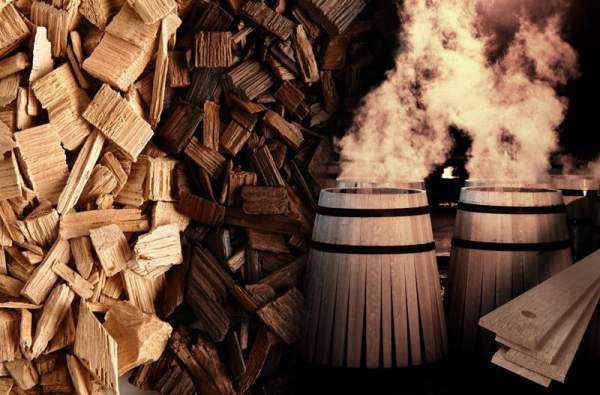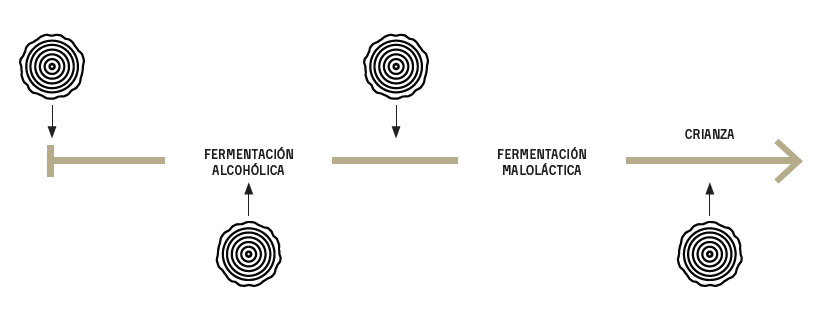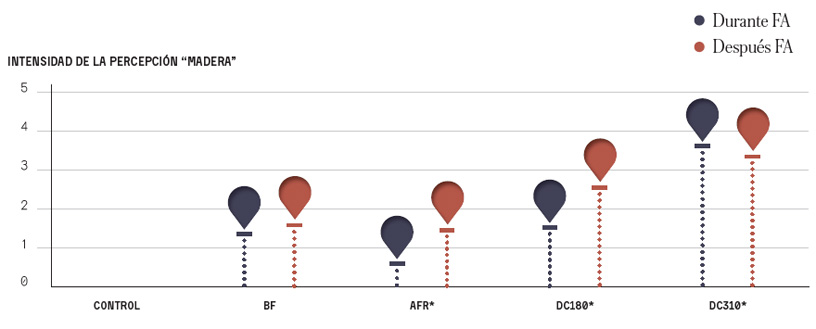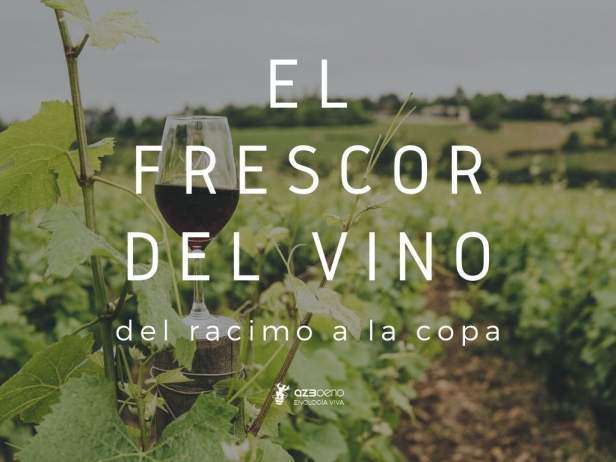
Wine and wood have an ancient and close relationship where they complement one another.
Both are natural products and their qualities depend on the circumstances of the vintage. As each one has a different composition and characteristics, we must try to find complementarity between them.
Through the wood, we look for more stable wines, with more color and fruit. We will also look for a higher volume and a higher tannic quality.
To achieve these objectives, the timing of the application of the wood is essential. Using a wood in alcoholic and malolactic fermentation does not have the same effect as in aging. Depending on the wine and the objective sought, you have to adjust the type of wood and the time of application.

1. In alcoholic fermentation.
The presence of yeast during alcoholic fermentation transforms, and even absorbs, some molecules from the wood, thus changing the aromatic impact.
In addition, together with the volatilization of the CO2, the integration of the wood is generally greater.
Woods which are barely or not toasted reduce their intensity during fermentation due to absorbtion of the microorgamisms.
However, las woods with a greater quantity of furfurals increase the toasted sensation in the wine compared to usiung them after alcoholic fermentation. Therefore, it can be said that the integration of furfurals is lower during this fermentation.
This can be interesting for wines with a fast rotation and a search for sweetness in the mouth.

In the case of white wines, the woods help to increase sweetness, complexity and length in the mouth without the perception of wood.
In the case of red wines, the use of unroasted wood can help reduce the sensation of insufficient maturity, masking the vegetal character of the grape and changing the profile of the wine.
2. Between Alcoholic Fermentation and Malolactic Fermentation
Once alcoholic fermentation has taken place, we know what the grape can offer. At this point, the polyphenolic and polysaccharide compounds that help to create the structure of the wine will have finished workingf so the profile of the wine can be interpreted both on the nose and on the palate.
Depending on the vintage, maturity, pump-overs, fermentation temperatures, etc., the desired balance goal has not been achieved and the structure, volume and even sweetness need to be increased.
That is to say, at this stage the wine that the enologist has in mind can be created, or a deficiency can be corrected.
As the identity of the wine is already known, and the pH is still low (without MLF), the anthocyanins are mostly in free form. With the help of oxygen, forming an ethyl bridge, these anthocyanins polymerize with the tannins. This means the color of the wine is stabilized and its decay decreases, once the MLF is finished.
Using untoasted wood will help enhance the fruit and increase intensity after alcoholic fermentation. Toasted woods, for example, change their profile from coffee notes to more caramel or vanilla notes with the help of oxygen. Therefore, it may be interesting to combine the use of wood for different taste purposes: rebalancing the mouth, reducing the aromatic impact of the wood through oxygen and achieving more integrated work between wine and wood.

3. After Malolactic Fermentation and Aging
In this case, the free anthocyanin content of the wine is very low, that is to say most of them have precipitated or are polymerized. As there are no free anthocyanins, polymerization will take place between the wine’s tannin and the wood’s tannin. Consequently, the violet color will diminish and will contribute to dryness in the mouth.
When it comes to using wood at this time, this polymerization must be taken into account, because woods with a high amount of ellagitannins increase the structure of the wine, but also dryness.
Therefore, it is necessary to analyze the wine and know and interpret how much ellagitannin it can support to achieve a mouth with volume and balance.
In this case, washed woods with a limited amount of ellagitannins are highly recommended. These woods enhance the aromatic expression and alter the sensations in the mouth
Related news
THE FRESHNESS OF THE WINE, from the bunch to the glass
The fashion for fresh wines has ceased to be fashion to become a trend; more and more consumers are looking for elegance, length and freshness above all.
More than winemaking machines
The winemaker is the artist who observes the vineyard, interprets it and imagines the wine that could be produced from this plot.
Was it the wood or the process?
Today, we are thinking about one of the most important stages of production: the aging of the wine.


